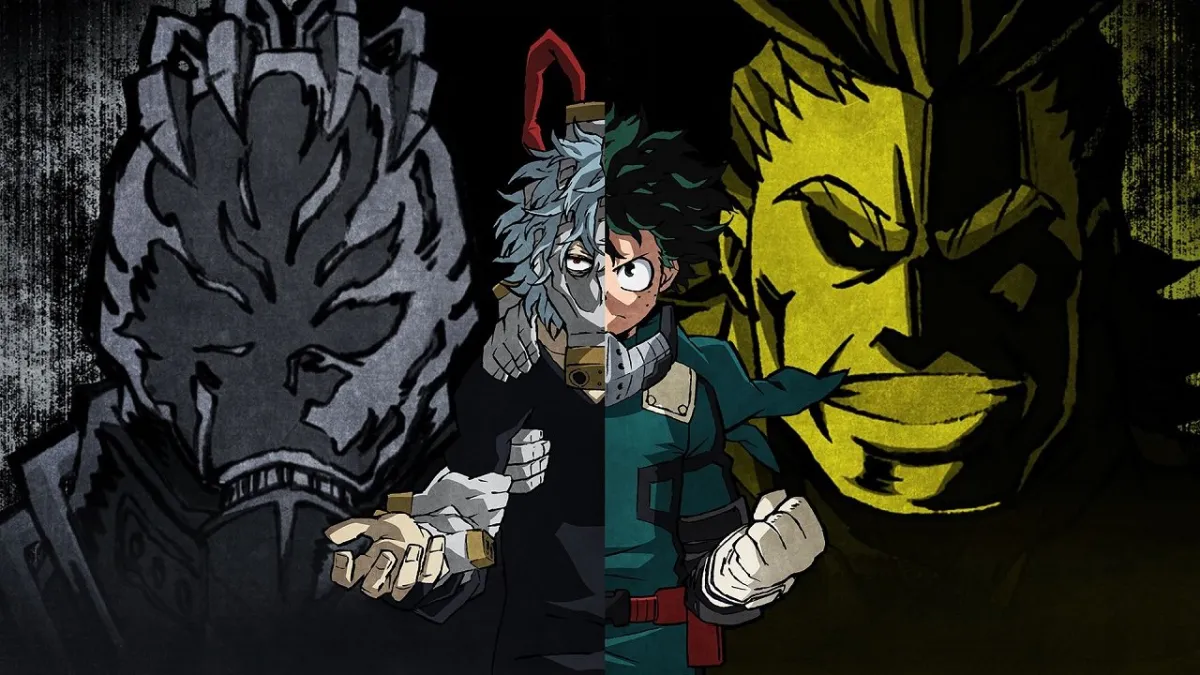After conquering just about every other format and platform, Kohei Horikoshi’s “My Hero Academia” is ready to move on to consoles and PC with My Hero One’s Justice.
“My Hero Academia” has been a cornerstone of Weekly Shōnen Jump’s lineup ever since it burst onto the scene in 2014, bringing readers a near-weekly dose of over-the-top action intertwined with a heartfelt story that will leave them counting down the days until the next chapter once they’re done with the current one.
Thanks to its popularity, what was once a story confined to a weekly manga, has since gone on to become a media powerhouse (in both Japan and overseas), getting a spinoff manga, three anime seasons (with a fourth along the way), a film and a game on the 3DS.
Now in 2018, it’s poised to get another one — My Hero One’s Justice — bringing the series’ signature action and aesthetic to consoles and PC, meaning I, as as a fan, am forced to ask an important question: does this have the franchise’s ethos intact, or are we looking at a cheap cash grab?

Back when I reviewed Little Witch Academia: Chamber of Time, I separated these types of games into two categories:
- One that merely seeks to profit off a franchise, offering little more than passing similarities with the source material.
-or-
- One that expands the franchise, seeking to draw players into the source material’s world.
At the time, I stated Chamber of Time was definitively the latter, taking the series’ signature characters, aesthetic, theme and wrapping them into an original story that was indistinguishable from the anime from which it was inspired.
So how did My Hero One’s Justice do by comparison? Not quite as well, unfortunately. The core gameplay is good enough, and while this is definitely a “My Hero Academia” game through and through, it feels like both Byking and the localization team at Bandai Namco only went for the bare minimum at times.
As an example, there is no dub — something that seems odd given the worldwide popularity of the series and the fact that a dub for the anime already exists. Even worse though, is that there are no in-battle subs either. I usually don’t care about the lack of dubs if there are subs present, but a game such as One’s Justice, which is supposed to channel the ethos of the source material, needs at least one of them. Instead, it got neither. Why?
At the very least, I can say the core gameplay didn’t receive similar treatment.

The easiest way to describe the combat here would be a cross between Naruto: Ultimate Ninja Storm and Dragon Ball Xenoverse, taking the assists from the former and just about everything else from the latter sans the Stamina Meter and replacing Ki with an energy meter solely used for super attacks (called Plus Ultras).
Battles are moderately-paced, trading in the focus on input speed and reaction times for accessibility; allowing those who play fighting games casually to jump in with minimal effort — something made all the easier with the presence of auto combos (called Normal). However, there is some amount of depth for those who are looking for it. My Hero One’s Justice has all the trappings of a decent fighting game and playing on Manual, where auto combos no longer work, allows all of the game’s mechanics — and a character’s full range of abilities — to come into full view. For instance what was once a simple attack string where Midoriya hits the opponent several times before sending them into the air and back down again, can turn into him hitting them per usual, but instead using Daytona Smash to launch them into the air before finishing the aerial assault with a charged version of Delaware Smash or even the Plus Ultra version (and receive a temporary power boost from activating Full Cowl afterwards) if you do the proper inputs. You obviously have to do more work to pull this off, but the damage tradeoff is worth it.

And just how I mentioned Midoriya’s Full Cowl, Daytona Smash and Delaware Smash, you can be sure that each member of the roster is similarly a perfect reflection of their anime and manga counterpart. Bakugo is a frenzy of explosions thanks to his Explosion quirk; Toga is quick, has an assortment of knives to use at any range, and can even transform into her opponent using her Transform quirk; while Todoroki, using his Half-Cold Half-Hot quirk, can unleash a dazzling onslaught of fire and ice to both burn and freeze his opponents. Uraraka was a particular favorite of mine, using a combination of her Zero Gravity quirk and Gunhead Martial Arts to surprising effect; such as using her quirk to lift various debris from the ground and having the option to either use it to augment her normal attacks, or as part of her Home Run Comet technique to launch them from afar.
After seeing the wonders Byking did with the characters who made the cut, I did feel a little miffed over those who didn’t. If it could design Tokoyami to have a different moveset depending on whether his Dark Shadow quirk is active or alter the properties of Yaoyorozu’s attacks based on which equipment she used her Creation quirk to, well, create, then surely it could have at least come up with something for Ashido, Shoji and Sero too.
Of course, I’m not going to use that as an excuse to disregard the work it did do; especially when the developers went so far as to even reference the drawbacks of certain quirks after the respective character does a particular move. For example, Midoriya’s sleeve and fingers will be damaged upon using his Delaware Smash Plus Ultra, Kaminari will make a dopey face and give a thumbs up after discharging too much electricity, and Uraraka will vomit after using her Uravity GMA Plus Ultra.

If I were to levy one complaint against combat, however, then it would have to be the lack of balance. Despite giving everyone a guard meter, which depletes so long as their guard is active, Byking decided to further reduce defensive options by making it impossible to guard in the air or adding some means to emergency evade or dodge at the expense of some meter. This means that if your opponent is using the right character and has you cornered while you’re in the air, you have little recourse other than calling your assist to avoid getting stuck in an infinite loop — an option that isn’t always available to you and might not always work when it is. Furthermore, certain characters don’t even need to use this oversight to do an infinite combo of their own, making Kirishima’s on-command Hyper Armor look tame by comparison.
That aside, between the over-the-top combat, clean appearance, faithful recreations of each character and interactive environments (many parts of most arenas are destructible and will even reveal new sections to fight in as they’re destroyed), each and every battle brings the series to life — comic book sound effects and all.
Unfortunately, I can’t offer the same level of praise for the single player content that precedes all the action. Whereas, the combat and overall aesthetic was lovingly-crafted with a clear reverence for the source material, the single player felt like an afterthought, merely seeking to retell past events without doing anything to give them more depth or further the narrative.

One’s Justice’s single player campaign retells the events between the U.A. Sports Festival and Hideout Raid Arcs (ch.22- 97/ep.14-50) in a series of single round battles from the perspectives of both the heroes and villains. And to it’s credit, Byking was successful at distilling the key events into a 2-4 hour (depending on if you read everything) package. You’ll be missing out on minor events and dialogue, for sure, but you can use this mode as a replacement for the aforementioned chapters/episodes and not feel like you’re missing out.
And though I admit it succeeded in that regard, there’s no escaping the feeling it was a missed opportunity to do something greater — namely including custom characters and a game-exclusive arc.
If there was any point in My Hero One’s Justice where it wouldn’t have been unusual to introduce a custom character, then it would have been the U.A. Sports Festival. Just like how the source material introduces several recurring characters, the game could have introduced one of its own and use him or her as the nexus for an original story. It could even parallel the events of the actual story by having the custom character go off on an internship, like everyone else did during the Vs. Hero Killer arc, before taking their Final Exam and later participating in the Forest Training Camp. Hell, it could have just done its own thing so long as Horikoshi gave his approval.

The absence of custom characters is particularly disappointing here because the game is loaded with customization options for pre-established ones. Using the rewards earned from Story Mode, along with the other two single player modes, Mission Mode — a mode where you take three characters of your choosing to duke it out against the CPU in a series of challenges of increasing difficulty and the added stipulation of your health not recovering between each fight — and Arcade Mode, you can change just about every aspect of a character’s costume, from their color scheme to the attached accessories — even those belonging to characters who aren’t part of the roster. Hell, you can even change their pre and post-battle quotes (though, again, it doesn’t mean much if there’s no subtitles to know what they’re saying). Seeing all the available options will no doubt encourage some fans to design the costume of their dreams. For me though? I’m a purist — I barely touched the feature.
All of this makes for a lopsided experience that mars an otherwise decent product. The story mode is essentially a throwaway, offering nothing to older fans of the series; Arcade Mode is, well, Arcade Mode, and the Mission Mode, though offering some amount of reprieve from the usual through special conditions, doesn’t offer enough to warrant coming back to it. Honestly, that’s the issue with the single player content in general — it’s short and offers no reason to come back to it once you’re done. Get your rewards, head to multiplayer and never look back.

The Verdict
My Hero One’s Justice takes the essence of “My Hero Academia” and wraps it into a decent package. There are some definite shortcomings, such as the uninspired story mode and missing subs, but the clean appearance and accessible combat makes up for it — if you allow it.
In the end, the level of enjoyment you get here will depend entirely on who you are and what you’re looking for. If you’re looking for a serious fighting game or something packed with content, then this won’t be for you. But if you’re a fan of the series, even a casual one, then there’s little reason not to have fun here. As for me, all I can hope is that Bandai Namco and Byking take another stab at the franchise; because their first go at it wasn’t great, but it wasn’t bad either.











Published: Oct 24, 2018 10:00 am